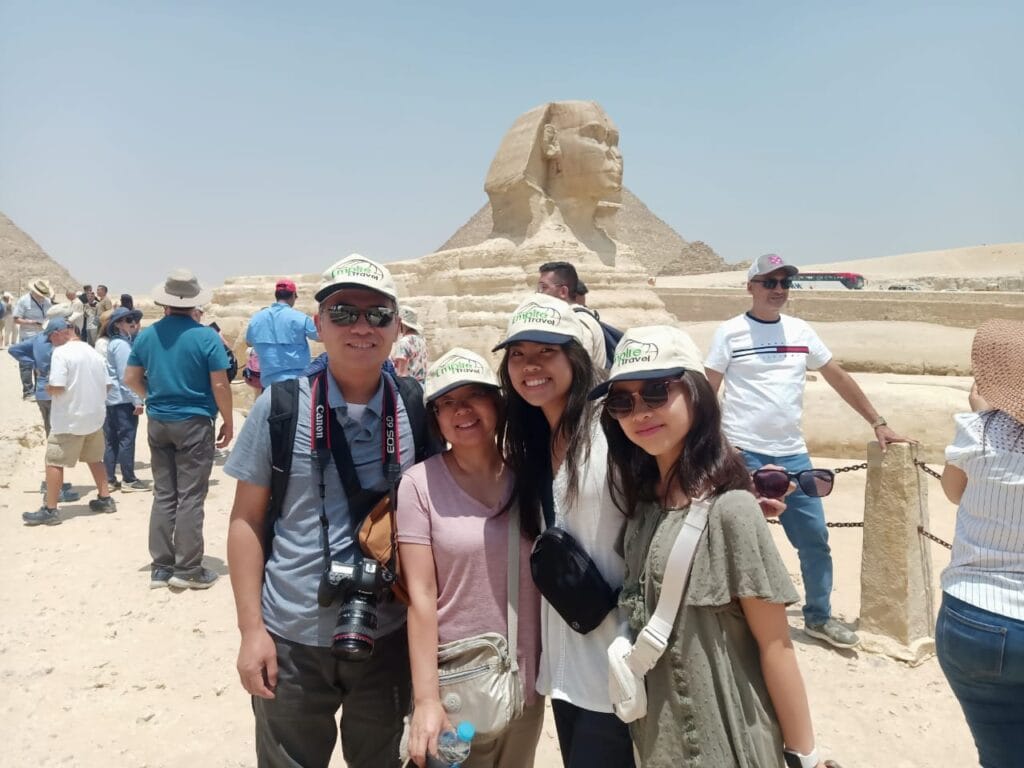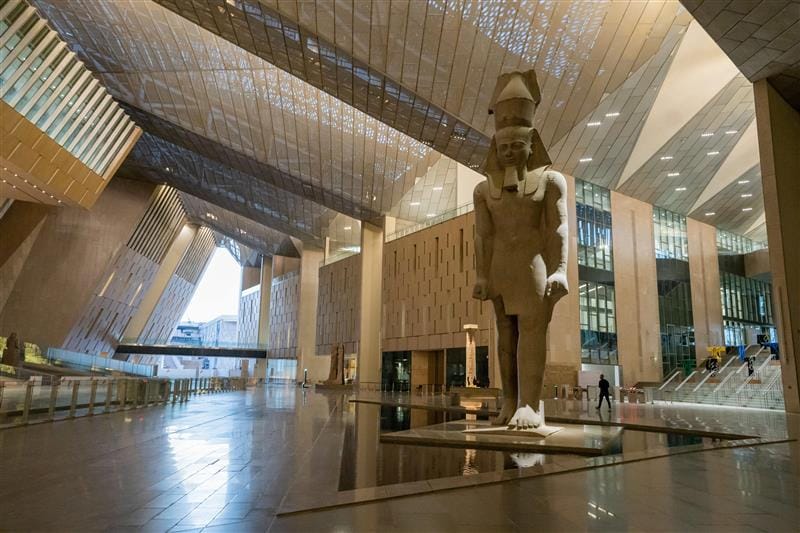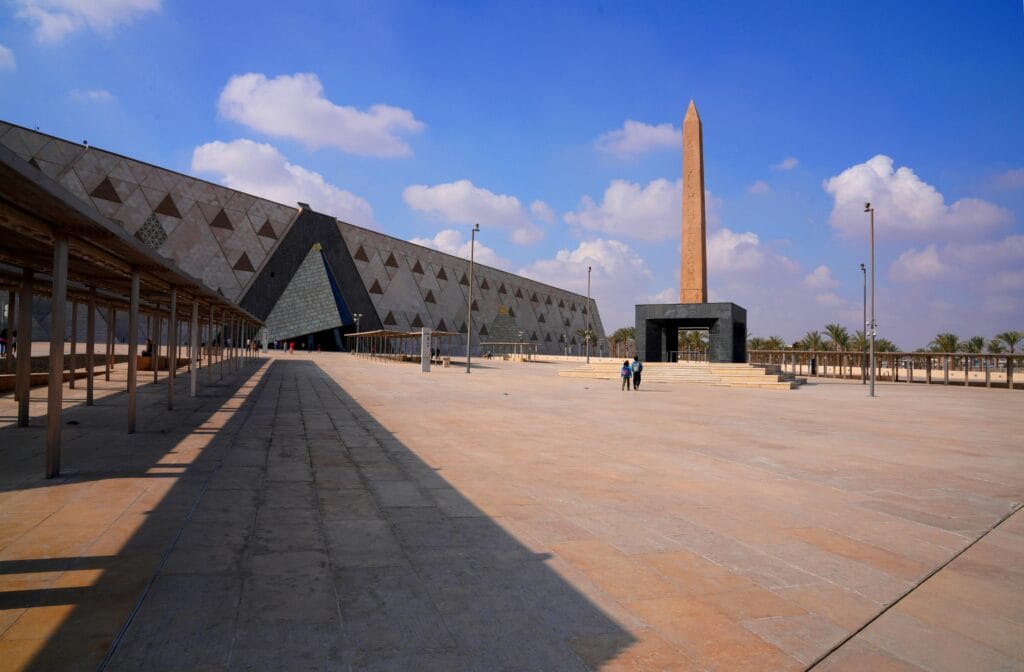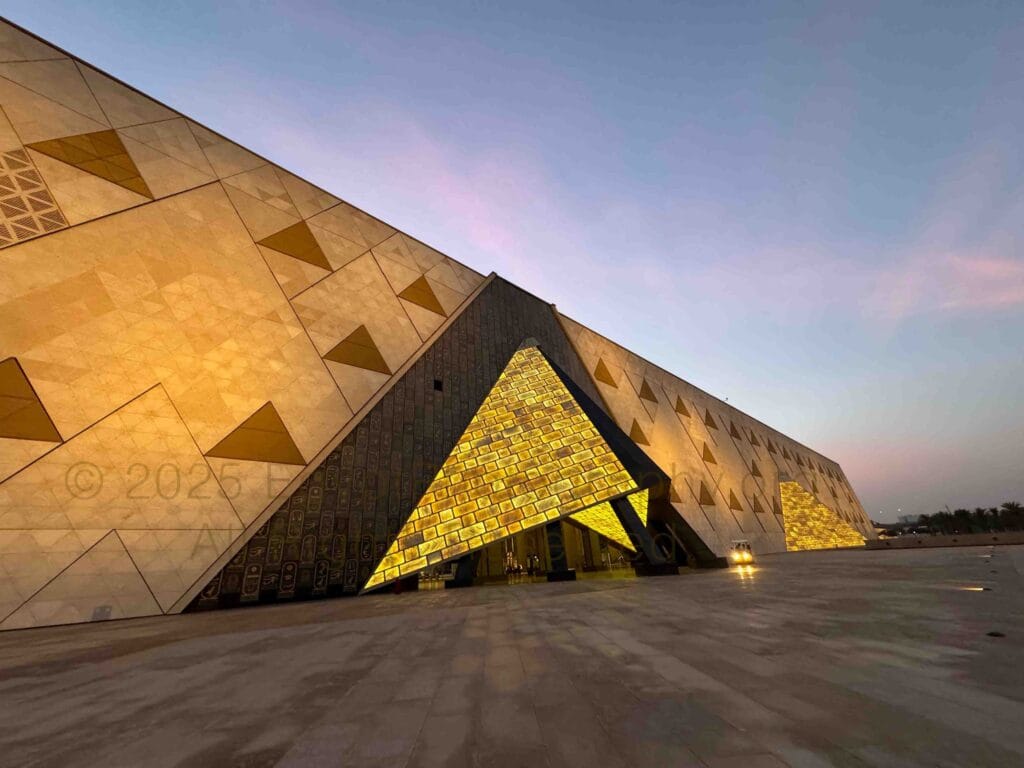
The Grand Egyptian Museum (GEM)
Location: Egypt, Cairo/Giza

The World’s Largest Single-Civilization Museum
The Grand Egyptian Museum is the world’s largest archaeological museum dedicated to a single civilization, housing over 100,000 artifacts distributed among 12 main permanent exhibition halls. The museum encompasses approximately 81,000 square meters of exhibition space on a 500,000-square-meter site positioned between the edge of Cairo and the desert.
The project’s journey has been remarkable. An international design competition launched in 2002 received over 1,500 entries from 82 countries. Construction began in 2005 and was fully completed in 2023 at a cost of $1 billion. The opening has been postponed multiple times due to political upheavals, financial challenges, the COVID-19 pandemic, and regional conflicts.
Architectural Marvel Aligned with Ancient Wonders
Designed by Heneghan Peng Architects, the museum’s triangular architecture features a translucent stone facade composed of locally sourced alabaster. The facade is decorated with cartouches and ovals surrounding Egyptian hieroglyphs bearing the names of kings and queens.
The building’s north and south walls line up directly with the Great Pyramid of Khufu and the Pyramid of Menkaure. A new tourist walkway connects the GEM to the Pyramids of Giza, letting visitors stroll between the two landmarks.
The Grand Entrance Experience
The Atrium (Great Hall) serves as the main entrance hall with an area of 10,000 square meters. Inside, a six-story Grand Hall contains the 3,200-year-old statue of Ramesses II beneath a roof that admits diffused sunlight.
An open staircase serves as a transitional gallery with more than 60 artifacts, leading to the 12 halls. Spanning 6,000 square meters, the structure stands six stories tall (approximately 50 meters). The Grand Staircase has 108 steps bringing people up the equivalent of six floors to the main galleries, with colossal statues on view the whole way up.
Tutankhamun: The Crown Jewel
The complete King Tutankhamun collection comprising 5,398 pieces is displayed in a 7,500-square-meter section of the museum. This marks the first time King Tutankhamun’s treasures, over 5,000 items, are displayed together in history, including his famous golden mask and throne.
The museum includes a one-to-one reproduction of the scale of Tutankhamun’s tomb, with projections of the chambers showing how packed it was with objects he might need in the afterlife: objects to eat, to hunt with, to sleep.
Additional Treasures
The museum houses artifacts from various periods of Egyptian civilization, from the Predynastic Period to Coptic Egypt, with at least 20,000 displayed for the first time ever. The galleries are arranged by three pillars: society, kingship, and beliefs, which are further divided into four periods: the Old Kingdom, Middle Kingdom, New Kingdom, and the Greco-Roman period.
Other highlights include the restored Khufu solar boat, which scholars believe was either used in Khufu’s funeral procession or intended for his journey with the sun god Re in the afterlife.
World-Class Conservation and Research
The Grand Egyptian Museum’s Conservation Center is one of the largest conservation and restoration centers in the world and the largest center for the restoration of antiquities in the Middle East. It was established in 2006 and opened in 2010.
The center houses 19 laboratories including those for the restoration of mummies, wood, stones, wall paintings, and metals, in addition to laboratories for preventive conservation and scientific documentation. It also contains six storage rooms for preserving artifacts in controlled environmental conditions. An underground tunnel connects the main building to the specialized laboratories dedicated to safeguarding Ancient Egyptian heritage, from fragile papyri to sculptural fragments and human remains.
Visitor Information
Since October 2024, the museum has received approximately 1.5 million visitors over 10 months during the trial opening, with an average of 4,000 visitors per day. The GEM aims to welcome up to five million visitors each year.
The entrance fee for adult foreign visitors is 1,450 Egyptian pounds (approximately €30). Tickets for Egyptians are EGP 200 (approximately £3), demonstrating the museum’s commitment to welcoming the local population.
The GEM complex is open from roughly 8:30 AM to 10:00 PM, with main galleries timed around 9:00 AM to 9:00 PM on selected evenings. Visitors should allocate at least 3-4 hours for the museum to take in major galleries.
A Strategic Vision for Egypt’s Future
Egyptian officials hope the new museum will boost the country’s tourism industry and the still-struggling economy. Beyond the galleries, the GEM includes public spaces with retail shops, local dining options, and landscaped gardens, making it a full-day destination for families and tourists alike.
If a visitor were to spend one minute looking at each artifact on display in the museum, it would take almost 70 sleepless days to view the entire collection.
The Grand Egyptian Museum stands as both a testament to ancient Egyptian civilization and a bold statement about Egypt’s cultural future, bringing together millennia of history with cutting-edge museum technology and conservation practices.
The Grand Egyptian Museum officially opens November 1, 2025, with public access beginning November 4, 2025.
Sources
- Grand Egyptian Museum Official Website (https://www.visit-gem.com/)
- Euronews Culture (October 30, 2025)
- CBS News (October 30, 2025)
- ArchDaily (October 31, 2025)
- Travel And Tour World (October 31, 2025)
- The Art Newspaper (October 30, 2025)
- Egyptian Streets (October 28, 2025)
- AFAR Magazine (July 2025)
Frequently Asked Questions (FAQs)
The Grand Egyptian Museum (GEM) is the world’s largest archaeological museum dedicated to a single civilization. Located near the Giza Pyramids in Cairo, Egypt, it houses over 100,000 artifacts from ancient Egypt, including the complete King Tutankhamun collection.
The museum is located in Giza, approximately 2 kilometers from the Giza Pyramids, making it easy to visit both attractions in one day. It’s about 20 minutes from downtown Cairo.
Absolutely! The museum’s proximity to the Giza Pyramids makes it ideal for a combined tour. Many visitors explore both sites in one day. Check out our tour: Pyramids of Giza & Grand Egyptian Museum (GEM) Tour.
The GEM is truly exceptional for several reasons:
- It’s the world’s largest archaeological museum, spanning over 500,000 square meters
- For the first time in history, the entire Tutankhamun collection (over 5,000 artifacts) is displayed together in one place, with many pieces never before seen by the public
- The museum features state-of-the-art technology and interactive exhibits that bring ancient Egypt to life
- Its stunning architecture and strategic location offer breathtaking views of the Giza Pyramids
- The Grand Staircase showcases colossal statues in a dramatic three-story display
- It represents a monumental preservation effort, providing world-class conservation facilities to protect Egypt’s treasures for future generations
- The museum creates an immersive journey through Egyptian history, from prehistory through the Greco-Roman period





